
Celebrate ten years of Urban Omnibus and support ten more years of fresh, independent perspectives on citymaking with a donation today!
Celebrate ten years of Urban Omnibus and support ten more years of fresh, independent perspectives on citymaking with a donation today!
Though New Yorkers who have passed on no longer have use for a unit of housing or spot on the train, there is a spatial reality to death. Determining a person’s final resting place, and the logistics of transporting the body there, is largely a private matter for most. But for New York’s indigent and unidentified, who lack the family members or means for a traditional burial or cremation, internment becomes a public service handled by the City.
Some of these individuals end up buried on Hart Island, a largely inaccessible and unseen 101-acre potter’s field in the Long Island Sound administered by the Department of Correction. Today, the island holds more than a million bodies in unmarked graves. Thanks to recent advocacy work by the non-profit Hart Island Project and the New York Civil Liberties Union, public awareness of the site’s existence and implications is growing; efforts to remove bureaucratic hurdles to information and opportunities for family members to visit their loved ones’ gravesites have progressed in tandem. A nascent movement to convert Hart Island into City parkland — following a long tradition of burying grounds as places for public recreation — has also arisen, mored by a commitment to respectful remembrance of the individuals interred on Hart and ecological concern for a landscape that’s been degraded by intensive, mass burials. Here, journalist John Surico traces the processes and policies that bring bodies to rest on the island and reports on the ongoing debate around how and by whom this necessary but controversial burial ground is managed. –J.T.
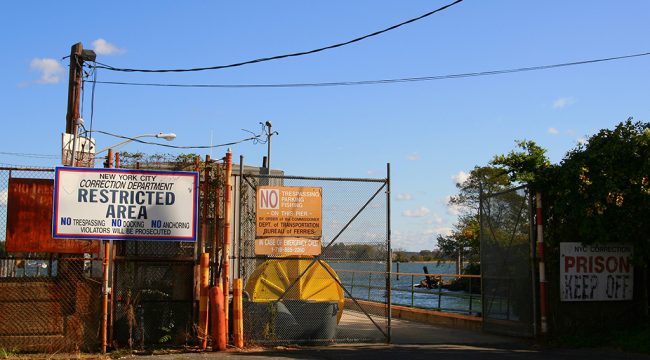
A fence surrounds the Department of Correction ferry dock on City Island | Photo by Alan Houston
A loud, blaring horn rings out when the ferry takes off for Hart Island.
It is barely past nine on this steamy August morning in the quietly nestled neighborhood of City Island. After a two-hour trip from Astoria by way of three subways and a bus, I had reached the end of Fordham Street, where a sign clearly marks a dock as Department of Correction territory. The head of our impending voyage, Captain Martin Thompson, stands guard at a small table with a clipboard and a manila folder, the former for check-in (a reservation is required), the latter to hold cell phones until we return. No photos allowed where we’re going.
Once onboard, the Department of Transportation-operated boat feels more like a barge than the ferry that carts people and their minimalist furniture to and from IKEA. I stare across the large and open-ended deck to the Long Island Sound, the only thing between me and the water a rope at knee-level. Our trip to Hart Island is over in just fifteen minutes.

City Island (lower left) and Hart Island (lower right) lie just east of Pelham Bay Park in the Bronx. | Photo by Doc Searls
The reasons for spending an hour at the city’s only extant potter’s field, the location of upwards of a million burials since 1869, greatly varied among my fellow passengers. One man had made it his mission to visit every island in the city. Another said it was his birthday, and a ferry ride in each borough was his gift to himself. Two young women were interested in the island as it relates to black history in New York City. Another duo, two older black veterans, was here to pay their respects to fallen soldiers buried in a Civil War veterans cemetery that once existed on the island. But none were there to visit family; only to see this relatively unknown place for themselves.
Upon arrival, our movement was limited. A small gazebo marks the visitors’ boundary that runs less than 50 feet away from the dock. A gray slab in the grass delivers a biblical passage dedicated to those buried in the potter’s field. To the right, overgrown buildings decay beside a dirt road that leads to unknown territories. Off to the left, an empty field extends for a distance before meeting a copse of trees. You cannot see, only know, what exists past them: burial grounds that consist of 70-foot-long trenches. Stacked three caskets high, each trench can hold about 150 adults. A new one has to be dug every few months.
Stepping foot on Hart Island immediately provokes a feeling that is hard to explain. It is an uncomfortable grief, particularly if you understand how many people have been buried beyond those trees. You feel they were forgotten, left here so far from the rest of us until someone remembers. As I stood in the gazebo, I was left asking three questions about this small piece of land on the literal fringes of New York City: how did anyone end up on Hart Island, how did we end up with this potter’s field in the first place, and what might it one day become?
···
Nearly 140 people die each day in New York City. Some have religious burials; others are cremated. Regardless, most bodies in New York find a resting place for their eternal sleep thanks to their loved ones. But about 1,500 a year do not.
On any given day, New York’s hospitals hold deceased residents without a designated estate administrator. Usually homeless or abandoned, these indigent New Yorkers end up concentrated in the morgues of the city’s eleven public hospitals, where the City begins a process to provide for the body. This can take a while.
“There is no fixed time period or deadline because every case is unique,” said a spokesperson for the Office of Chief Medical Examiner (OCME), the City agency in charge of the process of releasing the body back to the world.
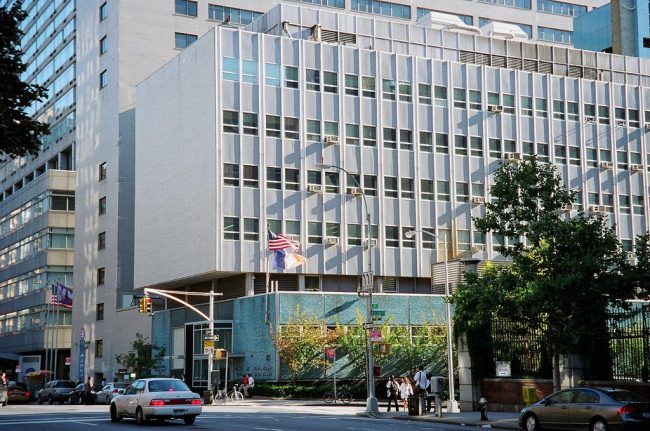
Headquarters of the Office of Chief Medical Examiner of the City of New York | Photo by Eden, Janine and Jim
The City first works to find out who the person is. If a name is found, staff of the public hospitals and employees from the Medical Examiner’s office search for the next of kin, the person who will decide what to do with the body. In fortunate situations, a willing family member will come forward and either pay for a private cemetery or opt for “burial assistance.” This option, provided by the Human Resources Administration (HRA), subsidizes the cost of a burial with up to $900 for funerals costing $1,700 or less. One source likened it to applying for food stamps or a housing voucher.
From September 2014 through August 2015, the burial assistance program funded 547 burials at a cost of $421,438.32, which, an HRA spokesperson told me over email, “includes burials with unusual circumstances where exceptions to policy are secured and the amount paid exceeds the $900.” The HRA spokesperson characterized this standard allowance, set by the State in 1987, as “clearly inadequate” to cover the high costs of contemporary funerals. The growing expense has to do in part with space: room in private cemeteries is increasingly limited, and churches now have strict standards for who can purchase plots. The HRA supports increasing the burial assistance allowance, and funeral homes will sometimes lower fees for those with limited funds.
But traditional burial, even assisted, isn’t always an option. If the City is unable to identify an individual — now rare thanks to recent advances in identification technologies — the body is buried on Hart Island. There it awaits future investigation should new evidence or information about the identity become available.
Sometimes, family members are found, according to the OCME official, but choose to relieve themselves from the duties of burial “for reasons they may or may not disclose.” When a reason is given, the spokesperson said it’s generally either cost or the belief that City Burial or City Cemetery — the official terms for Hart Island — is the “appropriate option for their circumstances.” More common is a body that no one retrieves. The morgues, coping with daily deaths, start to crowd.
Cremations might seem a good solution to this capacity issue. But New York State, like many others, legally requires the authority of kin to burn remains. So the City is left with no other option but burial. After what is usually, according to the OCME spokesperson, a month-long wait, the body reaches its final stop: Hart Island. There, it is joined by stillborn babies whose parents are either unable to afford a funeral or too saddened to claim the body.
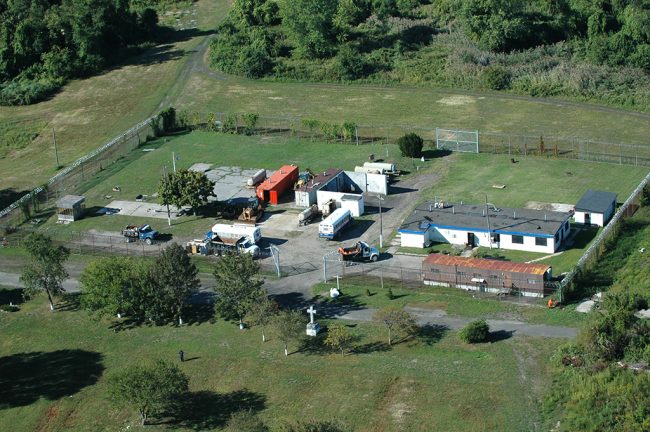
Department of Correction compound on Hart Island | Photo © 2010 Melinda Hunt/The Hart Island Project
More than a million New Yorkers have gone through this process, unknowingly selecting a City Burial. For today’s unclaimed, a refrigerated truck picks up their bodies from the morgue and drives to City Island, where the same ferry I rode transports the truck to Hart Island on an almost daily basis. The minute the morgue truck arrives, the jurisdiction of death is transferred from the Medical Examiner’s office to the Department of Correction.
When we dock, I saw this truck idling, then drive off toward the grave sites followed by a smaller pickup. Three men in roughed-up jumpsuits stood in the pickup’s bed, holding onto the cab as they laughed and enjoyed the hot morning weather. They were inmates from Rikers Island, specifically residents at the Eric M. Taylor Center, which houses those with shorter stays. Selected by lottery for what’s known as “island duty,” each inmate is, according to a DOC spokesperson, “screened by DOC classification and security for factors such as violent crimes, gang affiliation, contraband infractions, and escape risk” before they are assigned to Hart.
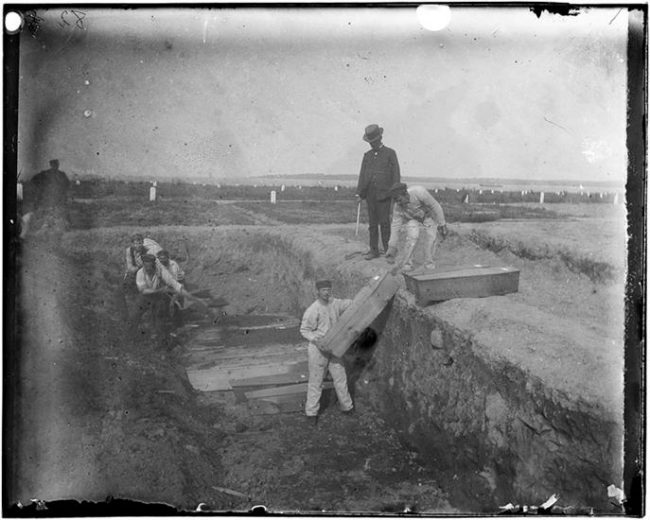
“The Potter’s Field, the Common Trench,” taken circa 1890 on Hart Island | Photo by Jacob A. Riis, courtesy of the Collections of the Museum of the City of New York
In a twist to an already dismal situation, those interned at Rikers — another restricted access island, just eight miles away, housing an overwhelmingly impoverished population against their will — make 50 cents an hour laboring to inter bodies confined to pine boxes in mass graves. A Department of Correction spokesperson said the agency spends upwards of $550,000 a year (a mere fraction of the agency’s 2015 $1.068 billion budget) to maintain and operate the potter’s field.
The one silver lining is that a future on Hart Island is not permanent: at any given time, a family member may come forward and ask the DOC to disinter the body. Approximately a hundred happen each year. So in some respect, Hart Island is tragic in its transience; it’s what the City is doing in the meantime for those left behind. In a metropolis of 8.5 million people, where space seems to always be limited, it’s a de facto accommodation. But to think: a million people are still left there in limbo, until that rare occasion when they can be honored properly by their kin.
For decades, family members were not allowed anywhere near the bodies of their loved ones — only through disinterment could they lay them to rest, off the island. Even after “closure” visits to the gazebo were gradually allowed, the island’s gravesites remained off limits. So did information on exactly where an individual was buried — the lack of a comprehensive database of the City’s death certificates made accessing this information very difficult. So family members not only had to come to terms with their loved one’s burial on a desolate island in the Sound; they also had to grapple with not knowing where he or she lay.
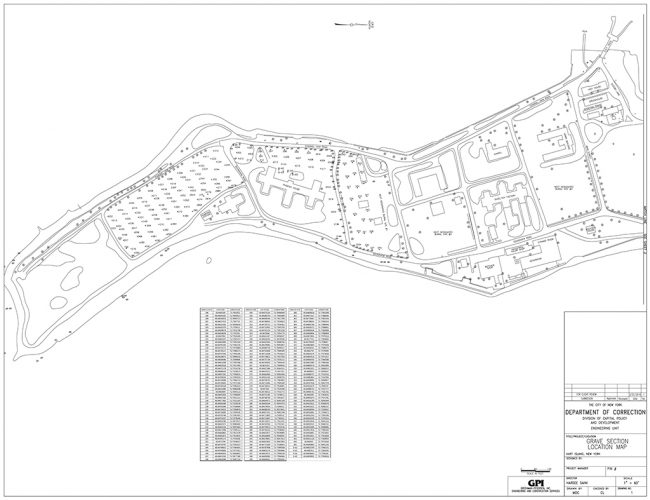
Hart Island site map with burial locations | Image via NYC Department of Correction
These bureaucratic obstacles were the basis of a lawsuit against the City of New York filed by the New York Civil Liberties Union on behalf of family members last year. In July, the suit proved successful: the City agreed to add two round-trip ferry rides to Hart Island one weekend day a month for family members and up to four guests. And for the first time in Hart Island history, family members could visit the graves of loved ones to finally pay their respects.
“We said, ‘This is just completely wrong and you have to fix it,’” Christopher Dunn, the lead NYCLU counsel on the case, told me over the phone. “To me, it was bureaucratic inertia. They did nothing, so we sued.”
In addition to monthly visits, the settlement also spurred the DOC to update their online public database to cull information from the Medical Examiner’s office within 30 days of a burial and include plot designations.
For Dunn, the lawsuit’s true success is the crack it created in a process that has been opaque for decades — an opacity I experienced firsthand as a visitor to the island and, more acutely, as a reporter. All quoted spokespeople requested anonymity for this story; an Health and Hospitals Corporation spokesperson refused to comment; a DOC spokesperson referred me to the website’s FAQs when I first inquired about the island; and an inmate at Rikers Island was denied clearance when I asked for a phone interview.
So this lawsuit, Dunn argues, could be the first step in overhauling Hart Island once and for all. “With families visiting regularly,” he told me, “the City has a strong incentive to open up.”
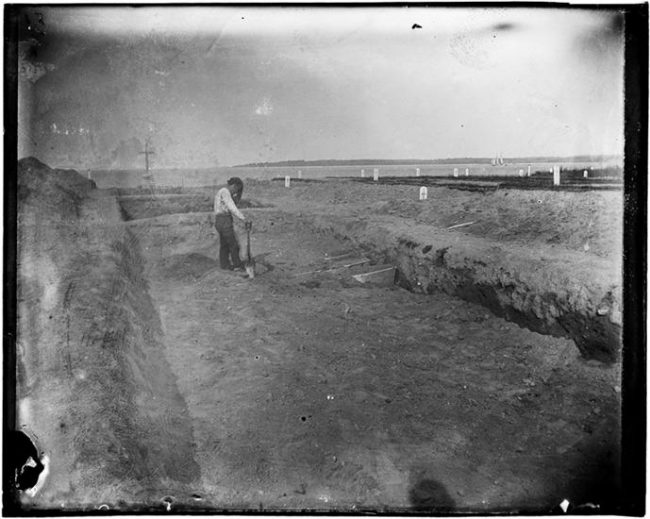
“The Potter’s Field Consecrated Ground,” taken circa 1890 on Hart Island | Photo by Jacob A. Riis, courtesy of the Collections of the Museum of the City of New York
Just south of the visitors’ gazebo, there is an old stone house and church, degraded and abandoned, that belonged to the family that once owned Hart Island. The Hunters leased their land most famously for boxing matches and, during the Civil War, the federal government used a section of it to train one of the Union’s rare black regiments and hold captured Confederate soldiers.
After burials were prohibited in downtown Manhattan in 1851, outer borough cemeteries began to swell in population. In 1868, New York City purchased the island from Edward Hunter for $75,000 and the migration of bodies to Hart Island began. A boy’s workhouse — an outpost for juvenile young men connected with the jail on Blackwell’s Island (present-day Roosevelt Island) — was soon established to bury the dead. During the Great Depression, the jail was permanently moved from Blackwell’s to nearby Rikers Island.
Early on, the federal government still shared the island with the City, using its property for Navy disciplinary barracks during World War II and later to store now-defunct Cold-War-era Nike missiles underground. Over time, these operations ceased, and Hart Island became the City’s de facto potter’s field — a term that originated in the Gospel of Matthew — with enough space to meet the demands of rising immigrant, homeless, and general populations.
But that was well after the City exhausted its other burial options, the contemporary grounds of which are now enjoyed by millions of people every day. City Hall Park served as one of the city’s first potter’s fields in the late 1600s. Once filled, the City relocated the operation to Madison Square Park, an ideal site given its proximity to Bellevue Hospital. After an epidemic led to its closure, Washington Square Park came next, followed by Bryant Park and the land on which the Waldorf-Astoria was built in 1931.
“The potter’s fields were the beginning of our park system,” Melinda Hunt, the founder of the Hart Island Project, told me in a phone interview. “Can the burial grounds be safe for future generations? It’s always been a role of the New York City park system to make public cemeteries safe and accessible. The issue now is how to do so while City Cemetery has active burials.”
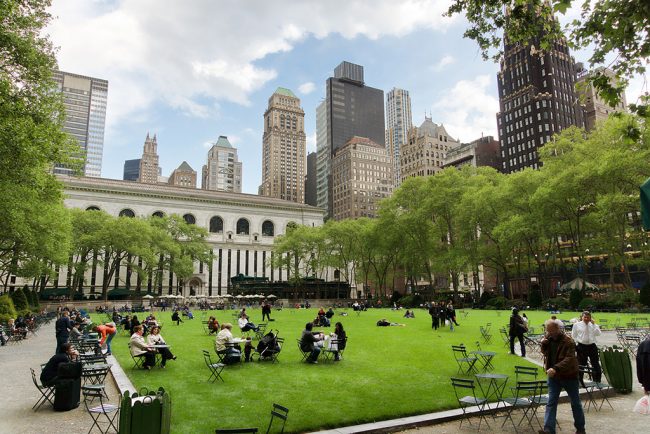
Bryant Park, former site of New York City’s potter’s field | Photo by Jean-Christophe Benoist, via Wikimedia Commons
Hunt, a Canadian-born visual artist, became intrigued by Hart Island when she arrived in New York during the AIDS epidemic. Numerous AIDS victims are buried on Hart Island; in fact, the only individual grave belongs to the first newborn to die from the disease. Hunt’s initial interest arose from the lack of healthcare available for the impoverished and how the issue has been pushed to the edge of the city where no one can see it. “I’m a visual artist, and this is something that has been invisible,” she added.
Today, Hunt is one of the most vocal critics of the island’s management. In many ways, her group’s action presents a direct contrast to the City’s lack thereof. When the City didn’t have a database for family members to search for their loved ones, the Hart Island Project did (the City’s new database, Hunt said, actually uses the Project’s archive). When the City couldn’t provide family members with images, the Hart Island Project used Google Earth to give them an idea of what the island looked like. When the City barred access to gravesites, Hunt and her team tried to change that. The group’s latest creation, the Traveling Cloud Museum, is an extensive crowd-sourced website where family members can post stories and details about their relatives buried on Hart Island.
For Hunt, the major issue with Hart Island stems from the agency that ended up with responsibility for burying the city’s dead — how, in a sense, the Department of Correction is not giving the bodies the burials they deserve. “Correction officers are not trained in managing a landscape, and they’re not stabilizing the land through planting the right things,” Hunt told me. “They’re not replacing foliage quickly enough. The burial areas are barren a decade later with nothing to hold the soil and graves in place. Heavy vehicles drive over the mass graves, compacting the soil and collapsing the gravesites.”
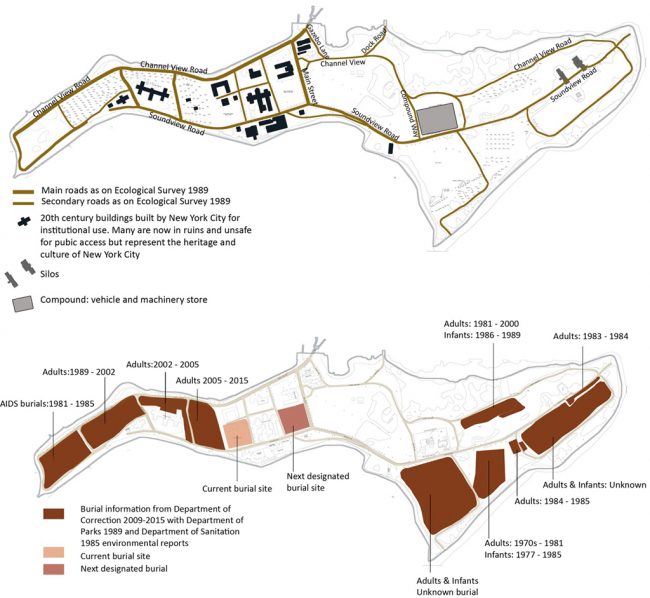
Burial and infrastructure maps of Hart Island | Images courtesy of Ann Sharrock, Landscape Architect, and The Hart Island Project
Hart Island is also reportedly reaching capacity: the northern side of the island is full, so burials have been moved to the more shallow southern side, near the former workhouses. Hunt told me that those structures are being demolished to make room for more bodies. She was frank: “At the moment, we have big open pit burials.”
The operation’s degradation of the island’s physical environment deserves immediate attention, argues Hunt. Hart Island is extremely vulnerable to erosion, and the cancer-causing formaldehyde used to embalm the bodies poses a threat to the city’s waterways.
“You shouldn’t treat the environment like that, let alone the person,” Hunt told me. “Get the prison system out of it; it’s not their job to bury the dead. They just inherited it from the workhouses, and the workhouses are gone. It’s just kind of amazing that it exists.”
This is the motive behind the latest push to transfer jurisdiction of Hart Island to the Parks Department, or, in Hunt’s opinion, its rightful owner. Queens Councilwoman Elizabeth Crowley has introduced a bill in the City Council to do just that. Crowley contends that the Parks Department could come up with an eco-friendly landscape plan for the island that will protect surrounding areas while allowing burials on a select part of the island to continue. In order for parkland and burial sites to co-exist, the Councilwoman is encouraging the offering of natural burials, which use biodegradable caskets and no embalming chemicals. Though tragic, demand for a locker in the city’s morgues will continue to exist, and the bodies of New Yorkers left behind will need a final home, no matter what. But perhaps it doesn’t need to feel so detached from the rest of us.
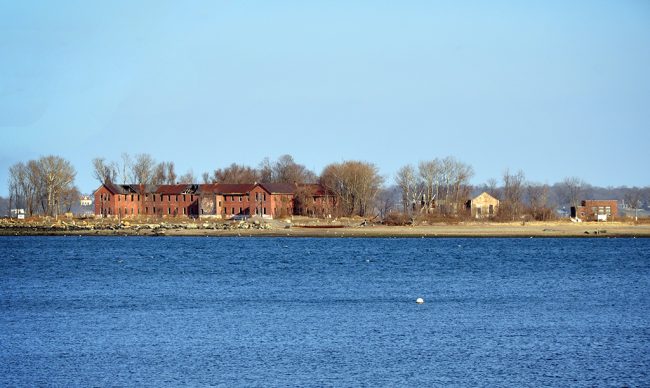
Hart Island’s abandoned Phoenix House, a former drug rehabilitation center | Photo by David Trawin
“I think this could be sort of an environmental and socially conscious place for people to be buried,” Councilwoman Crowley told me. “In addition to that, you could make the island safer to access. … The only safety concerns are the buildings that are falling apart.”
The Councilwoman pointed to the Smallpox Hospital landmark on Roosevelt Island’s southern tip as a model for structural stabilization. On Hart Island, she sees the old Hunter home, Civil War memorial, and missile silos as historic sites that could one day anchor a public park, thereby transforming Hart Island from what many consider a blemish on the city’s conscience into a grand experiment in urban green infrastructure.
“We don’t have that much green space. Most cities don’t,” Councilwoman Crowley told me. “ Why not take advantage of this opportunity to create more?”
Every person who traveled to see New York City’s potter’s field promised themselves that they’d return.That question must contend with the reality of local supply and accessibility: Pelham Bay Park, the city’s largest green space, spans 2,772 acres nearby, and Hart Island is, as I experienced, not exactly easy to get to. And as the Parks Department’s capital budget has fallen, hard-to-reach parks, versus more local or well-used green spaces, could drop on the agency’s priorities list.
Still, in the coming months, the Councilwoman said she’ll sit down with Correction and Park officials to discuss logistics — in other words, whether this transfer can actually happen. A Council hearing on her bill, which has gathered 25 sponsors, will take place in November or December. In the meantime, the plan seems to be gaining momentum: in January, Bronx Community Board 10 voted in support of the idea, and, in early September, Manhattan Community Board 5 voted unanimously to do the same. But not everyone is necessarily on board.
“Hart Island is still an active burial site, which poses challenges in converting it to a publicly accessible park,” Monica Klein, a deputy press secretary for the de Blasio administration, noted in an email.
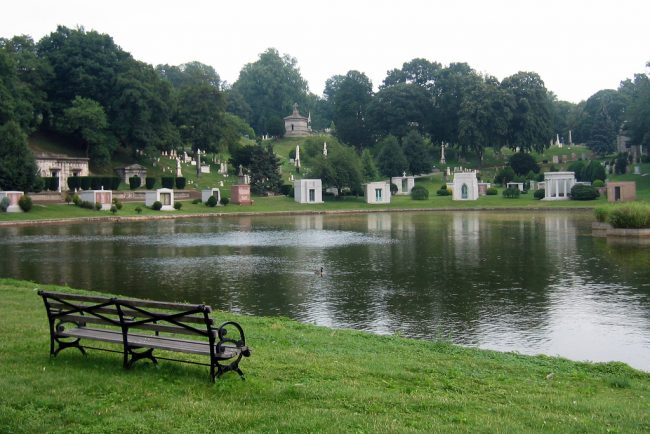
Green-Wood Cemetery | Photo by Wally Gobetz
But in other parts of New York, operating a cemetery as a de facto green space doesn’t seem to be a problem. Green-Wood Cemetery in Sunset Park, Brooklyn, one of the big “rural” cemeteries that began to pop up around the country in the early nineteenth century, remains an active burial site and a popular attraction. In addition to treating it like a park, a place to walk and picnic, people also come from all over to visit the graves of Leonard Bernstein, Jean-Michel Basquiat, and other notable New Yorkers. At one point, it was even the second largest tourist attraction in the state, ranking just below Niagara Falls.
There are other concerns. A spokesperson from the Mayor’s Office said the Parks Department does not have the experience to operate an active burial site, nor the financial resources to manage one 101 acres in size. The spokesperson also affirmed that the Correction Department considers Hart Island a “solemn responsibility.”

Rikers Island inmates maintaining Hart Island burial grounds | Photo © 2010 Melinda Hunt/The Hart Island Project
The Councilwoman told me she believes Correction officials will ultimately side with her; solemn or not, it is a responsibility and cost that the DOC, she argues, doesn’t want to deal with anymore. This is a shift that family members will likely support as well. Right now, she adds, “I just feel it’s like visiting an inmate on Rikers Island. You go through scanners and have documents that you have to produce.”
Growing awareness of Hart Island’s existence may be the greatest benefit to her campaign. When a grieving family member contacted her about Hart Island, she hadn’t known much about the place. Some of her fellow Councilmembers are just starting to go through the same learning process.
“In a city with over 8 million people, and the demands that we get — whether it’s homelessness, housing, public education, or public safety — dead people are very non-priority for many,” Councilwoman Crowley told me. “We’re planning for the living.”
···
At the gazebo, the questions for Captain Thompson quickly multiplied.
Why can’t we go to the graves? Why is this visit only once a month? Why couldn’t we bring our phones? Is there any way we can go to the gravesites if we aren’t family? Why so strict? Is anything going to change?
The Captain handled them well — it was clear that he’s been doing this for a while. But he couldn’t answer some about the future of the island, and his non-responses set visitors who were quiet on the ferry abuzz with chatter over the possibilities.
The two women studying black history said they’d try to return with a family member of one of Hart Island’s interred. One veteran mentioned how he and fellow veterans would visit next month to lay flowers for the black regiment that trained here during the Civil War. The birthday man said he wished he had more time to explore but would definitely be coming back. And I, too, had an urge to return and see the graves: now that we had seen the grim island for what it was, we felt it to be dishonorable — unjust, even — to forget these people, like so many people had before us. Visiting them could at least be our token of remembrance.
Maybe this is the crack in the hard shell that has surrounded the island for over a century. On that August morning, as the fog lifted and the silhouette of Hart Island receded across the water, every person who traveled to see New York’s potter’s field promised themselves one thing: they’d return.
Correction: An earlier version of this article incorrectly stated that the settlement resulting from the NYCLU case spurred the creation of an online DOC database. The online database already existed; the settlement prompted the incorporation of plot information within it. The article also noted that nearly one million burials had occurred on Hart Island; more than one million have actually occurred. The earlier version erroneously listed the chronological order of New York potter’s field, with Washington Square Park preceding Madison Square Park.
The views expressed here are those of the authors only and do not reflect the position of The Architectural League of New York.
Comments